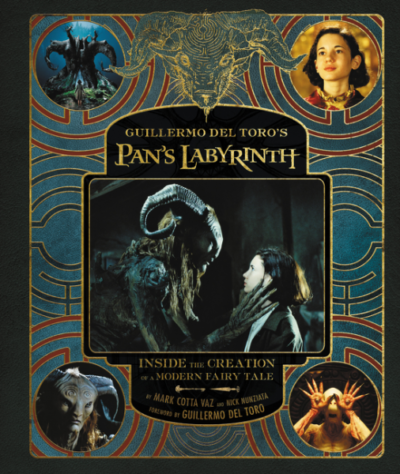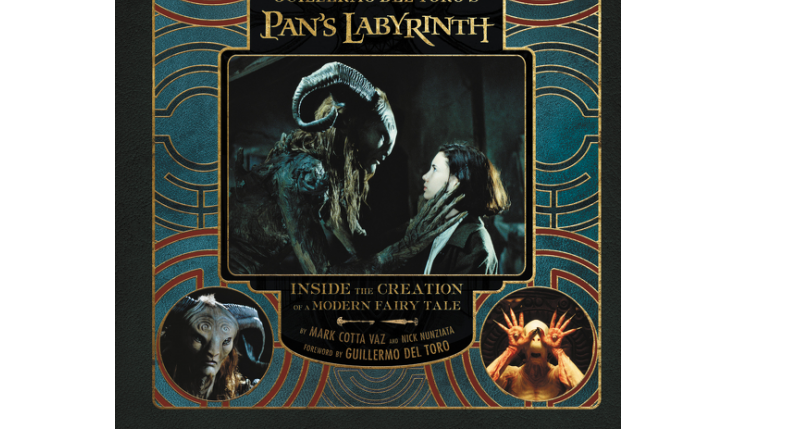INTERVIEW: Mark Cotta Vaz dives into Guillermo del Toro’s ‘Pan’s Labyrinth’ with new book

Pan’s Labyrinth, the cinematic masterpiece from influential director Guillermo del Toro, is gearing up to celebrate its 10th anniversary, and Harper Design is joining the festivities with the publication of Guillermo del Toro’s Pan’s Labryinth: Inside the Creation of a Modern Fairy Tale, written by Mark Cotta Vaz with Nick Nunziata and a foreword by del Toro.
The intricately designed book features original concept art from the film, rare unit photography from the set, an exclusive storyboard booklet and inside information from the cast and crew. Cotta Vaz had his work cut out for him to both honor the movie and explain the trials and tribulations the team endured to make the masterpiece a reality. The author achieved his goals with a lot of research and host of interviews, including some in Spanish conducted by Greg Solano.
“Sometimes these things require a team effort,” Cotta Vaz said in a recent phone interview. “There’s a lot of people that worked hard on this.”
Cotta Vaz has an impressive resume with more than 30 books to his name. Some of his most popular titles include the Twilight Saga companion books, The Invisible Art: The Legends of Movie Matte Paintings and Living Dangerously: The Adventures of Merian C. Cooper, Creator of King Kong.
When working on a project, he’s often asked to pick out images to accompany his words. For Pan’s Labryinth, the author didn’t have to deal with production design or image selection, but he has trained himself on being an effective visual writer. “I have a good visual eye, so a lot of the things I’ve done that involve visuals, I’ve selected and ordered them,” he said. “I haven’t done the actual layout, but I’ll usually put them in order, which really helps I think the production design because then [the photos] kind of flow with the text. In this particular case, I didn’t have anything to do with selecting the images, but, you know, you’re just sort of conscious. You write visually. You’re conscious that what you’re describing is going to have a visual counterpart paralleling it all.”
Cotta Vaz saw the landmark film when it first came out in movie theaters 10 years ago. He remembers thinking that del Toro’s story, which involves a young girl who discovers a wondrously imaginative fantasy world in 1940s Spain, was “enchanting” and “suspenseful.” The author appreciated that the movie doesn’t have easy, obvious answers. This is not a connect-the-dots drama that’s easy to digest.
After receiving the book project, Cotta Vaz needed to refresh his memory and watched the film again on Blu-ray. He also took in some of the commentary tracks and tried to immerse himself in del Toro’s world. “It was just as riveting I guess 10 years later,” he said.
The reporting stage was largely accomplished with phone interviews, although he did meet some of the creative team who live near his home.
“People were really interested in talking,” he said. “I loved David Martí from DDT, the makeup guys who did genius work. David was great because he was very honest about how difficult it is to do a project like this, and I really appreciate that. And I hope the readers appreciate it because I think sometimes in our mass media, [with] this kind of celebrity-oriented stuff, they talk about movies, and, you know, people have disagreements on the set, or there’s some issue, or creative differences tend to be made fun of or light of. And I understand that as being very important. I mean it’s integral to the process. Any creative process, if you get talented people together, you’re going to have differences, and David was really honest about how tough it was to make that movie.”
In the book, Del Toro admitted that the movie nearly killed him, although he was likely speaking metaphorically. So if anything, Inside the Creation of a Modern Fairy Tale cements the fact that movies are not only about the glitz and glamor. Often these complicated shoots require sweat and tears, logistical nightmares and disagreements, long hours and constant brainstorming.
“[It was a] Mexican and Spanish co-production being shot in Spain in Spanish, and no one thought it would become an international sensation,” he said. “Or that it would get a 22-minute standing ovation at the Cannes Film Festival when it debuted. It was kind of a dream project. Six Academy Award nominations, and they won three.”
Cotta Vaz said the book is truly an appreciation of the movie. It’s not meant as a marketing ploy. “To me, it’s film history when you get a chance to do these books,” he said. “It’s not marketing, but I think some people approach it that way. And so this is more of a different kind of making-of book. It’s a look back at a movie a lot of people say is a masterpiece.”
Although Cotta Vaz has some serious cinematic credibility when it comes to the books he has authored, he’s not the film buff one might expect. His early memories of seeing movies in the theater are of comedies like The Incredible Mr. Limpet and Abbott and Costello Meet Frankenstein. Later in life, he came to movies through his other profession.
“I sort of fell into it in a way just because I’m a journalist,” he said. “In fact, I just got another book project. One of my book projects got accepted by a New York publisher. We haven’t signed a contract yet, but it’s going to be a book on Pan American Airways during World War II. So I’m probably getting more into those sorts of other interests. My first book was Spirit in the Land. It was about kind of new age and indigenous religions in America. I did this cross-country thing going to Indian reservations and to spiritualist communities in Florida. It was just a whole different thing, but when I started writing for Cinefex magazine, which is sort of the top publication in terms of writing about visual effects in movies and television, that kind of got me connected and maybe more about writing about movies. As I’ve grown up, I love movies and particularly when I was in college. It was kind of an era where you watched a foreign film because it was cool and also because it connected you with deep thoughts.”
Certainly after reading Guillermo del Toro’s Pan’s Labyrinth: Inside the Creation of a Modern Fairy Tale, there are some deep thoughts to be had. There are explanations about the symbolism in the movie, the characters who populate the screen and the themes that del Toro tried to focus on. Taken together, it’s a testimony for how difficult a project like this cinematic masterpiece — and now it’s companion book — can be.
“I think if people read this book, they’ll understand, wow, it’s hard to make a movie,” Cotta Vaz said. “They had huge challenges on it. They were filming in Spain during the drought because they had restrictions on the pyrotechnics they could use, and they have this big battle scene and things blowing up. Well, they had to do that with smoke and mirrors, literally lights. … See the movie first. Then when you read the book, you go wow. You kind of see the art of it and the ingenuity of it to tell a story. I mean you can always write something with words, but to actually bring it to life, that’s the big challenge.”
By John Soltes / Publisher / John@HollywoodSoapbox.com
Guillermo del Toro’s Pan’s Labyrinth: Inside the Creation of a Modern Fairy Tale by Mark Cotta Vaz with Nick Nunziata and a foreword by Guillermo del Toro is now on sale. Click here for more information.

